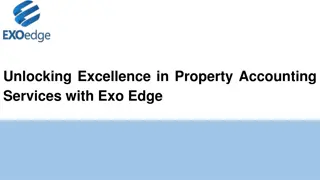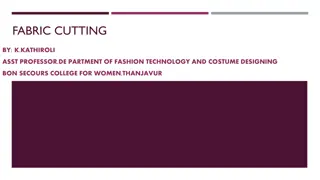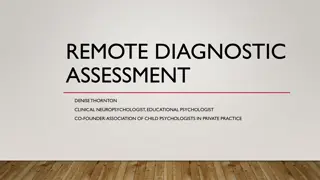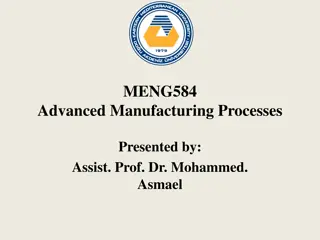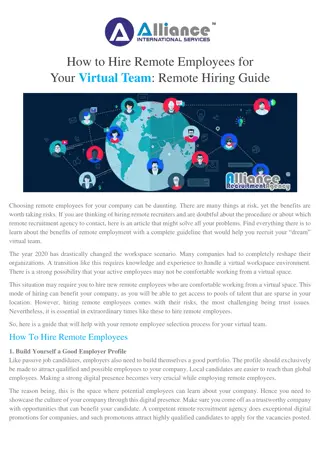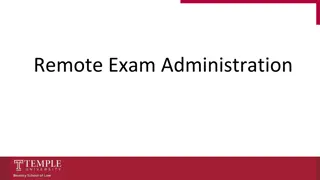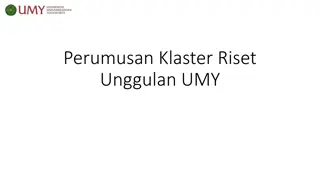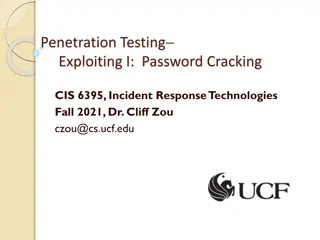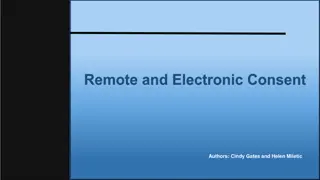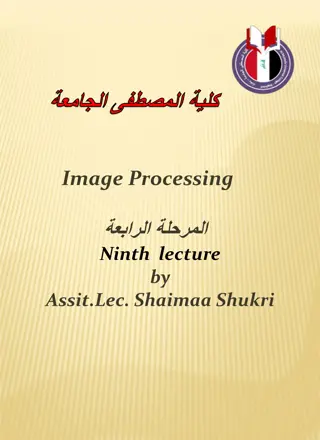Cutting-Edge Insights on Remote and eConsent in Clinical Research
Dive into the latest trends and considerations regarding remote and eConsent in clinical research, from increased use during the pandemic to potential future implementations. Learn about remote consent, eConsent, and their combinations, with insights on their impact on the informed consent process.
Download Presentation

Please find below an Image/Link to download the presentation.
The content on the website is provided AS IS for your information and personal use only. It may not be sold, licensed, or shared on other websites without obtaining consent from the author. Download presentation by click this link. If you encounter any issues during the download, it is possible that the publisher has removed the file from their server.
E N D
Presentation Transcript
ICTR Clinical Research Professionals Lecture Series ICTR Clinical Research Professionals Lecture Series Monday August 29th2022
WELCOME Clinical Research Professionals Lecture Series New Lecture Series geared to bring innovative and new topics to Clinical Research Professionals at Johns Hopkins https://ictr.johnshopkins.edu/events/clinical- research-professionals-lecture-series/ Topics are based on questions received from Clinical Research Professionals throughout Hopkins Welcome topic suggestions: sswords1@jhmi.edu Welcome speakers!
Agenda Remote & eConsent: Liz Martinez Research Participant Advocate Suzanna Roettger - Associate Director Compliance Monitoring Lauren Swedberg - Sr. Consent Form Specialist Questions and Discussion
Remote Consent and eConsent Both remote consent and eConsent were in limited use pre-pandemic. Not surprisingly, there was an increase in their use during the Covid-19 pandemic. Will there be continued or increasing use of these modalities in the consent process moving forward?
Remote Consent Remote consent is a consent process that allows the person conducting the consent and the potential participant to engage in the informed consent process in a way that is similar to what would be conducted in-person under normal circumstances without being in the same physical location.
eConsent eConsent is an electronic media/format that can be used to supplement or replace paper-based informed consent forms to provide information to a potential research participant. It can also be used to obtain documentation of consent (e-signatures.) eConsent can be conducted both in person or remotely.
Remote and eConsent Combinations of remote, e-consent, and or e-signatures can be used together to accomplish the Informed Consent Process. How these modalities are implemented should take into consideration the qualities of the research study, the type of participants, regulations, institutional policies and the research team itself. There is no single best way to execute these consent modalities for all research.
Use of Remote and eConsent The Research Level of Risk Complexity of the Study Acuity of Disease # of consents Research Team Level of Training Communication Ability Access to Technology Consent Method Participants* Demographics Access to Technology Trust/Acceptance Institution Local Resources IRB and Institutional Policy Laws/Regulations *See Resource: Chen C, Replacing Paper Informed Consent with Electronic Informed Consent for Research in Academic Medical Centers: A Scoping Review. (2020)
Remote Consent Best Practices FDA Guidance provided during the Covid pandemic provided detailed considerations for conducting remote consent processes. We can use this material to guide practices for appropriate conduct of remote consent processes.
Remote Consent Best Practices The person providing consent must have a copy of the consent form eConsent (to be discussed later in presentation) email (secure release) mail text provided in-person at a visit Best Practice: Provide the consent form for review prior to discussion. Ask the potential participant to write out their questions.
Remote Consent Best Practices phone videocall telemedicine Best Practice: landline Best Practice: secure platform Best Practice: when available Best Practice: Elements of the study described in the form will be presented Conversation about these elements will occur The participants questions will be answered The participants understanding will be evaluated
Remote Consent Best Practices Remote signatures must include a method to ensure that the signer of the consent form is the person who plans to enroll as a participant or is authorized to sign for the participant Best Practice: The person obtaining consent must verify the appropriate person physically signed the consent document : view via video conference or, obtain a photo of the signed consent document or, obtain verbal confirmation that they signed the consent form or agreed to participate electronically. A signed consent document must be in possession of the study team before any study related procedures are initiated.
eConsent Best Practices FDA Guidance document published in 2016 provides considerations for the use of electronic consent processes in research.
eConsent Best Practices Whether part or all of the eIC process takes place on-site or remotely, the responsibility for obtaining informed consent remains with the investigator and the study personnel to which responsibility has been appropriately delegated. The investigator cannot delegate the authority to obtain consent to the electronic system. FDA Guidance Use of Electronic Consent (2016) Best Practice: As with in person consent using paper forms: Present the elements described in the form Converse about these elements Answer the participants questions Evaluate the participants understanding
eConsent Best Practices eSignatures are an important part of eConsent Best Practice US: FDA regulated Investigations: In-person eSignatures -personnel may verify the persons identity Remote eSignature -must comply with 21 CFR part 11 (user name password combinations, computer readable ID cards, biometrics, or digital signatures.) OHRP/Research under 45 CFR part 46: Risk based identity verification which for minimal risk could mean no verification or waiver of documentation of consent.
Johns Hopkins DocuSign Johns Hopkins Instituted DocuSign as eSignature tool in 2020 Attention: DocuSign Costs may eventually be the responsibility of the study Choice based on: 21 CFR part 11 compliance Quick set up Study team ability to add forms Best Practice JH: Used for FDA and non FDA regulated research* (*if requested by study) IRB approved consent document uploaded as a pdf into DocuSign for use. JH developed and provided training which is required for all users.
DocuSign Continued To use DocuSign you will need to fill out a form from the DocuSign team at researchdocusign@lists.johnshopkins.edu Study must be approved by DocuSign team before submission to the IRB All signatures will be required as they would for any written consent form
Johns Hopkins DocuSign Experience Top Perceived Issues in use of DocuSign at JH: Participant problems logging in and/or accessing the consent in DocuSign Pediatric consents when child has to sign are not feasible Non-English consent problems Set up effort too significant for low enrolling studies
Johns Hopkins REDCap REDCap for eConsent and eSignature Research not requiring 21 CFR part 11 compliance System Readily available at JH Support on site Study team able to add forms
REDCap Can be used without modifications if the study is minimal risk and has been IRB-approved for a waiver of documentation of consent Modification is required to be used to obtain legally effective signatures (greater than minimal risk studies) Subject s identity can be verified with a code or authenticator There is a place for the subject to enter name or click to agree to participate Study team responsible for modifying REDCap IRB approved consent language added into RedCap by trained team member.
Johns Hopkins REDCap Experience RedCap eConsent/eSignature Experience RedCap eConsent and eSignature in use pre pandemic Roughly 110 studies currently using RedCap for research requiring a signature More using it for research not requiring a signature Top perceived issues with use of RedCap eConsent and eSignature at JH: In order to use RedCap for research requiring part 11 compliance there is a complex certification process that the site must execute (JH currently not part 11 compliant). Version control concerns with IC documents.
Remote and eConsent Best Practices Remote/eConsent consent methods need to be accurately documented When using remote consent/DocuSign a PDF copy (fully signed and dated by all necessary parties) of the consent should be uploaded to Epic with a research note indicating that remote/ eConsent was conducted. Utilize a consent checklist to document the informed consent process to confirm consent process completeness and compliance. A note to file or note on the consent checklist detailing specific dates when form was sent, when the conversation took place, who was there, explanation of differing signature dates, etc. Assure the participant has a copy of the consent form for their records (signed is preferred).
REDCap versus DocuSign Platform for presenting consent information electronically Platform for obtaining electronic consent signatures May included interactive elements: images, videos, narration or quizzes to aid and evaluate understanding Uses standard pdf image of the consent document. May not be used for FDA regulated research unless upgraded to Part 11 compliant May be used for FDA regulated studies (and others.) Signatures may not be legally valid (authentication and attestation needed) Signatures legally valid
IRB Approval These Consent processes must be IRB approved prior to implementation. Best Practice: Provide information to the IRB as to how you will satisfy each of the items discussed in the previous slides with your remote/eConsent process. When outlining your remote/eConsent plan for the IRB, include alternative options of obtaining consent from participants who cannot engage in a remote/eConsent process (*if this will be an option for your particular research.)
Submitting Remote/eConsent Requests to IRB How to request IRB approval for remote/eConsent Any consent method needs to be IRB approved before use Currently the eIRB system does not have a separate section for remote/eConsent Where you will include information and forms depends on whether the consent method is considered documentation of consent or waiver of documentation of consent
Submitting Remote/eConsent Requests to IRB Documentation of Consent Waiver of Documentation of Consent eIRB Section 15: Written Consent eIRB Section 16: Waiver of Documentation of Consent For documented consent methods: For non-documented consent methods: In-person consent with wet signature Oral consent script REDCap with ID verification Standard JHU REDCap Other eConsent where participant s identity is verified Other eConsent where participant s identity is not verified DocuSign
What to submit to the IRB: Remote/eConsent eIRB Section 15 DocuSign: Add language provided by the DocuSign team Remote consent: Add language from IRB website
What to submit to the IRB: Other eConsent eIRB Section 15/16 Other eConsent Systems: Explain the process for obtaining eConsent State what system you will use Explain that system is Part 11 compliant (if needed) Explain that system is able to document and authenticate consent (if needed) Confirm whether the electronic version includes all of the same information as non-electronic or explain differences Ex: graphics in electronic version
What to submit to the IRB: Remote/eConsent Consent Forms Remote consent using wet signature: No changes needed to the consent form DocuSign: Written consent form signature lines need extra space for DocuSign signature overlay PDF of written consent is used in DocuSign system
What to submit to the IRB: Other eConsent Consent Forms If you will only use eConsent Upload the eConsent form as a Word document Include the signature/ agree to participate page from the eConsent system in the Word document for the IRB to review You will receive a stamped PDF of the eConsent form
eConsent Script with REDCap Agree to Participate Page
What to submit to the IRB: eConsent Consent Forms If you will use eConsent and non-electronic consent Only upload the non-electronic version Having 2 versions of the same form greater chance of errors The format and content of the consent in the eConsent system should be as similar as possible to the non-electronic version. If there are differences between the non-electronic and electronic versions, explain in eIRB or upload the electronic version in a Word document for review
What to submit to the IRB: eConsent Consent Forms If you will use eConsent and non-electronic consent Uploadthe eConsent agree to participate /signature page by itself in the eIRB consent section if: - The signatures will be considered legally effective documented consent - The page differs from the non-electronic version (e.g. if you will be collecting DOB or phone number in the eConsent system) This page will be reviewed but not stamped
Sponsor/Other eConsent Systems Sponsor or other institutions eConsent systems may be used if they can be modified to include state law and Hopkins institutional requirements: Physician consent page Financial Information Sheet signature line Example: can add the physician consent as a separate survey in REDCap Sometimes these systems cannot accommodate Hopkins requirements and the study teams are not able to use eConsent
eConsents Consent Forms Reminder: Whenever edits to the consent form are IRB approved, don t forget to update the consent in the eConsent system
What to submit to the IRB: Outside eConsent Systems eIRB Section 20.2 If using a Part 11 compliant eConsent system, upload any of the following: A letter/email from the system owner verifying that the system is Part 11 compliant An official product descriptor of the eConsent system (i.e. from the eConsent system s official website) verifying it is Part 11 compliant An email from an IT professional at the host institution verifying the system is Part 11 compliant Documentation from the sponsor that the system is Part 11 compliant.
What a Monitor Expects Per FDA, HHS, and JHU requirements, consent documentation, regardless of the modality, must be obtained prior to the initiation of study procedures. The presence of fully signed and dated consent forms, in their original modality, either in hard-copy or electronic. Additional signatures must be obtained for internal options, Financial Information, and MD/APP, if applicable. That the methods employed are approved by the eIRB in 15.1/16.1 and specify the use of eConsent and/or remote consent
Remote/eConsent Questions? Review the Remote/Electronic Consent FAQ on the IRB website https://www.hopkinsmedicine.org/institutional_review_board/guidelines_ policies/guidelines/remote_consent_and_eletronic_consent.html Reach out to IRB staff with questions about remote or eConsent options
Questions? Contact Information: Stephanie Swords: sswords1@jhmi.edu Liz Martinez: liz@jhmi.edu Suzanna Roettger: sroettg1@jhmi.edu Lauren Swedberg: lswedbe1@jhmi.edu
Reference Rothwell, E., Brassil, D., Barton-Baxter, M., Brownley, K., Dickert, N., Ford, D., Wilfond, B. (2021). Informed consent: Old and new challenges in the context of the COVID-19 pandemic. Journal of Clinical and Translational Science, 5(1), E105. doi:10.1017/cts.2021.401
Resources Chen C, Lee PI, Pain KJ, Delgado D, Cole CL, Campion TR Jr. Replacing Paper Informed Consent with Electronic Informed Consent for Research in Academic Medical Centers: A Scoping Review. AMIA Jt Summits Transl Sci Proc. 2020 May 30;2020:80-88. PMID: 32477626; PMCID: PMC7233043. Conduct of Clinical Trials of Medical Products During the COVID-19 Public Health Emergency Guidance for Industry, Investigators, and Institutional Review Boards March 2020 Updated on August 30, 2021 https://www.fda.gov/media/136238/download Use of Electronic Informed Consent Questions and Answers Guidance for Institutional Review Boards, Investigators, and Sponsors December 2016 https://www.fda.gov/media/116850/download Vanderbilt Institute for Clinical and Translational Research RedCap eConsent Website https://victr.vumc.org/econsent_basics/
Learning as we go The pandemic spurred innovation and demonstrated the feasibility of different approaches to informed consent. Most concretely, e-consent and other remote consent methods were rapidly implemented in order to facilitate important research in a situation where traditional methods could not be used. Moving forward, more tools are now available to research teams, but important questions remain regarding how to use these tools most effectively in order to advance key goals of consent. It is especially important that novel platforms be harnessed to address, and not exacerbate, well-known problems with traditional informed consent. Rothwell, E (2021) Journal of Clinical and Translational Science.
Quick Look Data at JH The RPSS (Research Participant Satisfaction Survey) For 5 years we have been asking questions about how well the consent and consent discussions prepared participants for what to expect during the study During the pandemic we added a couple of questions about how consent was conducted Surveys completed July 2021 and February 2022
Quick Look Data at JH Semi-Annual Surveys (7/2021 and 2/2022) - Did the Informed consent form prepare you for what to expect during the study? 80% 70% 60% 50% 40% 30% 20% 10% 0% Yes, completely Yes, mostly Yes, somewhat No A mix of conversations taking place both physically in the same place and over telephone/video/computer (n=59) Mostly through the email or video or telephone conversations (n=71) Mostly while physically in the same place with a member of the study team (n=43)
Quick Look Data at JH Semi-Annual Surveys (7/2021 and 2/2022) - Did the information and discussions you had before participating in the research study prepare you for your experience in the study? 80% 70% 60% 50% 40% 30% 20% 10% 0% Yes, completely Yes, mostly Yes, somewhat No A mix of conversations taking place both physically in the same place and over telephone/video/computer (n=59) Mostly through the email or video or telephone conversations (n=71) Mostly while physically in the same place with a member of the study team (n=43)







